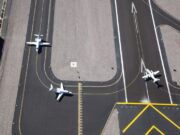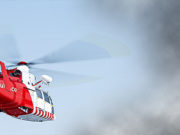
Accidents in the worldwide onshore resource sector crept slightly higher in 2018 to seven accidents, including four fatal accidents, but data gathered by Flight Safety Foundation’s Basic Aviation Risk Standard (BARS) program for 2017 and 2018 showed that accidents in those years were at the lowest levels in the past 11 years (Figure 1).
The data showed that a downward trend in both total accidents and fatal accidents began after both numbers peaked in 2012 at 36 total accidents, including 15 fatal accidents.
BARS, which is based in the Foundation’s Melbourne, Australia, office, works to improve safety in contracted aircraft operations within remote and hazardous environments, to raise aviation safety standards and to assist organizations in managing their aviation risk. In addition to its risk-based international aviation standard and safety auditing program, BARS also conducts aviation safety training programs and global safety data analysis.
Figure 1 — Onshore Resource Sector Accidents, 2008–2018
Source: Flight Safety Foundation Basic Aviation Risk Standard Program
Data released in late January included details on the seven accidents that occurred in 2018 in aircraft being flown in support of worldwide resource sector operations (Table 1), including the accident that resulted in the most fatalities — the June 24 crash of an Eagle Air Let L-410 UVP near Souguéta, Kindia, Guinea, which killed all four crewmembers. The aircraft had been transporting kerosene from Conakry to a mining company’s reserve depot at Léro.
The three other resource sector flights that resulted in fatalities were:
- The March 14 crash of an Aviator Group/Mackay Helicopters Eurocopter EC 135P2 that killed one person when it struck the water 30 km (16 nm) northwest of Port Hedland, Western Australia, while approaching a bulk carrier at night to pick up a marine pilot. The helicopter pilot was rescued from a life raft about an hour later with minor injuries, but a training pilot was not found.
- The May 2 crash of a Pilot Air Agusta Bell 206B3 in the Bélizon region of French Guiana that killed two people. The helicopter had been transporting engineers to a gold mining site where they were to repair machinery.
- The Sept. 2 crash of an Angara Airlines Mil Mi-8MTV-1 290 km (157 nm) southeast of Ust-Kut, Russia, which killed all three crewmembers. The helicopter had been on a charter flight to the Siberian Scientific Research Institute of Geology, Geophysics and Mineral Raw Materials.
| Date of Occurrence | Incident Location | Aircraft | Operator | Operator’s Country | Operational Role Sub Role |
Fatalities |
|---|---|---|---|---|---|---|
|
Source: Flight Safety Foundation Basic Aviation Risk Standard Program, Aviation Safety Network |
||||||
| Sept. 2, 2018 | Russian Federation | Mil Mi-8MTV-1 | Angara Airlines | Russian Federation | Passenger transport Geophysical |
3 |
| The charter helicopter flight to the Siberian Scientific Research Institute of Geology, Geophysics and Mineral Raw Materials crashed in daylight 290 km (157 nm) southeast of Ust-Kut. All three crewmembers were killed in the crash. | ||||||
| July 25, 2018 | Kobuk, Alaska, U.S. | Eurocopter AS 350 B3 |
Trans Aero | U.S. | Construction/sling loads External load |
0 |
| The helicopter rolled over during underslung load operations after colliding with low vegetation while performing a lateral maneuver. | ||||||
| June 24, 2018 | Guinea | Let L-410 UVP | Eagle Air | Guinea | Cargo transport Transport |
4 |
| The airplane crashed near Souguéta, Kindia, Guinea, killing all four crewmembers. The aircraft was transporting kerosene from Conakry to a mining company’s reserve depot at Léro. | ||||||
| May 2, 2018 | French Guiana | Agusta Bell 206B3 | Pilot Air | French Guiana | Passenger transport Transport |
2 |
| The helicopter was destroyed when it crashed in a dense forest toward the end of a flight from Cayenne to an alluvial gold mining site in the Bélizon region. The accident happened in daylight as the helicopter was transporting engineers to repair machinery at the site. | ||||||
| April 20, 2018 | Indonesia | Bell 429 | White Sky Aviation | Indonesia | Passenger transport Transport |
0 on board 1 on ground |
| A helicopter owned by PT Indonesia Morowali Industrial Park reportedly crashed in a nickel mining industry area in Bahodopi sub-district, Morowali district, Central Sulawesi, as the crew tried to return to the helipad for unknown reasons. No one in the helicopter was killed or seriously injured, but one person on the ground died after being struck by rotor debris. | ||||||
| March 15, 2018 | Russian Federation | Antonov An-12B |
Nimbus AK | Russian Federation | Cargo transport Cargo |
0 |
| The aircraft was transporting 9.3 tonnes (10.3 tons) of gold ingots from the remote Kupol gold mine in the Bilibinsky region to Krasnoyarsk via a refueling stop at Yakutsk. On departure from Yakutsk, 3.5 tonnes (3.9 tons) of cargo apparently broke away and fell through the rear cargo doors and onto the runway. The crew maintained control and the aircraft climbed away safely. It subsequently landed at nearby Magan Airport. | ||||||
| March 14, 2018 | Australia | Eurocopter EC 135P2 |
Aviator Group/Mackay Helicopters | Australia | Passenger transport Transport |
1 |
| The helicopter, with two flight crew aboard, was approaching a bulk carrier at night to pick up a marine pilot when it ditched/struck the water. Personnel on the merchant vessel notified emergency services, and one pilot was rescued from a life raft about an hour later with minor injuries. The second pilot, who was under training, was unaccounted for. | ||||||
Data showed that four of the 2018 accidents involved aircraft that were transporting passengers; three of those accidents resulted in a total of six fatalities (Figure 2). According to the data, passenger transport flights have been involved in more accidents since 2007 than flights of any other type.
Figure 2 — Total Accidents per Operational Role, 2007–2018
Source: Flight Safety Foundation Basic Aviation Risk Standard Program
Besides the passenger and cargo transport flights, the other accident flight was a Trans Aero Eurocopter AS 350 B3 that crashed on July 25 near Kobuk, Alaska, U.S., when it struck low vegetation during an external load operation.
Since 2007, a greater percentage of the worldwide total of resource sector accidents has occurred in North America (36 percent) than in any other region, and accident aircraft were more likely to be based in North America than in any other part of the world (38 percent; Figure 3). Southeast Asia recorded a smaller percentage of accidents (2 percent) than any other region, and the Middle East was least likely to be the base of operations for accident aircraft, according to the data.
Figure 3 — Percent of Accidents per Region
ASI = Asia; ASP = Australia–South Pacific; EUR = Europe; MEA = Middle East; NAC = North and Central America; RUS = Russian Federation; SAM = South America; WCA = West–Central Africa
Source: Flight Safety Foundation Basic Aviation Risk Standard Program
Three of 2018’s fatal accidents involved helicopters, and one involved an airplane, compared with data from 2017, when one helicopter and one airplane were involved in the year’s fatal crashes (Figure 4).
Figure 4 — Fatal Accidents, Rotary Wing and Fixed Wing
Source: Flight Safety Foundation Basic Aviation Risk Standard Program
The BARS program has conducted more than 500 audits of operators in 35 countries since completing its first audit in 2010. Although the program originated with audits of the resource sector, it has since expanded to aid humanitarian, government and insurance organizations and others in their oversight of contracted aviation activities and has issued BAR standards for helicopter external load operations, drones, offshore helicopter operations, night vision goggle operations, emergency medical services flights, aerial geophysical survey activities, and aerial livestock mustering.


